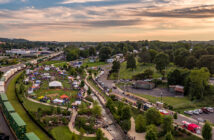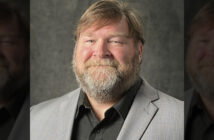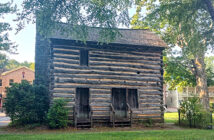
The American cemetery overlooks the deep blue waters of the English Channel, just above rugged cliffs stormed by troops on D-Day.
Editors Note: The following story was originally published in the May 25, 2013 edition of The News & Neighbor. We are republishing it here for the 74th anniversary of D-Day.
Two small children giggle and scamper around a seaweed-crusted concrete structure beached like an ancient whale on brown sand. Teenagers snap cellphone photos as they dangle their legs over the top edge of another house-sized cement block further down the beach. A few miles away, schoolchildren sit quietly beside white marble markers while their teacher points to engraved names.
Here, where past and future collide, exists the peaceful present-day coast of Normandy. On this day today in mid-May, gentle breezes and blue skies belie the hellish nightmare launched here nearly 70 years ago on D-Day.
Our group of eight— three couples from Johnson City, one couple from Tampa—decide to tour this historic site during a weeklong Viking River Cruise along the Seine River of France. Although it is only one of several excursions we take, the Normandy beach visit becomes the most meaningful experience of the trip.
The monuments are more than two hours by bus from the river. We drive past wide fields overflowing with sunshine-yellow flowers that will produce one of this region’s key crops, canola oil. Arriving first at Arromanches, we look through a small D-Day museum stuffed with dioramas, artifacts and maps and then we dine French-style in close quarters at a nearby brasserie restaurant.
Afterward, we stroll down the placid sands of Gold Beach, one of five sectors along the coastline targeted for the massive invasion. This site, designated for British troops, has visible remains of Mulberry B, a man-made harbor created from a string of concrete caissons fabricated in England and floated across the English Channel. The cement boxes, sunk to create a shelter from the turbulence of the channel, also serve as loading platforms for the ongoing deployment of war supplies and troops after the initial invasion. Intended for only three months of service, this temporary seawall nicknamed “Port Winston” winds up being used for almost a year between 1944 and 1945.
As our drive continues, we pause for a quick view of the remains of several German bunkers. One has a gaping roof, shattered by Allied bombs. A few others contain heavy artillery guns, still aimed northward where their relentless fire inflicted heavy casualties among the Allied forces.
Moving on, we head for Omaha Beach near the village of Colleville-sur-Mer. Our tour guide, Annie, is a Normandy native who tells us stories of her father and grandparents when their lives were under Nazi domination. She describes how they were forced into the woods during part of the invasion and had to survive unsheltered until Americans liberated the area.
Annie leads us to an open air pavilion, half-circling a 22-foot-tall bronze statue that dramatically captures the “Spirit of American Youth Rising from the Waves.” Our group joins a large cluster of other visitors, and we are asked to stand in two lines facing the cemetery. That’s when we see them… rows and rows of white marble crosses.
Almost 9,400 American servicemen and women who died between 1941 and 1945 are buried in this cemetery; 307 are unknown, and 1,557 more names are listed as missing in action. Yet we are standing among only a small portion of all the Allied soldiers who lost their lives during World War II.
A cemetery official explains that we will participate in a brief ceremony, one that is repeated several times each day with recorded music. We face one of two American flags beside a reflecting pool, and we place hands over hearts as our national anthem is played on bell chimes. Next are the sounds of a gun salute, followed by “Taps” played on a trumpet. The short service concludes with a moment of silence for all involved.
We watch as moist-eyed veterans are invited to have their photos taken in front of the statue. Our guide hands each of us a fresh rose to place on any grave in the lawn ahead.My husband, Mark and I begin walking among the markers, looking for graves of Tennesseans. There are many. We place our roses and walk on, stopping for a moment to view the mosaic ceiling of a Judeo-Christian chapel in the midst of the cemetery.
Scattered among the graves are markers with the Star of David instead of a cross, indicating that the fallen comrade is of Jewish ancestry. Almost all of these markers have a pebble or two placed on top. The tiny stones represent a Jewish tradition of remembrance and respect, as demonstrated in the movie “Schindler’s List” when mourners toss pebbles on Oscar Schindler’s grave.
For the unidentified, their markers bear simple words: “Here rests in honored glory a comrade in arms known but to God.”
The cemetery is hushed, despite the number of visitors. Even schoolchildren on a field trip are quietly respectful. Soft channel breezes come up from the adjacent beach, often called “Bloody Omaha” because of the carnage.
The massive Allied maneuvers that occurred here are hard to grasp. Planned for many months under the secret code name “Overlord,” the epic push begins on June 6, 1944, around six o’clock on the morning, with three airborne divisions of U.S., British and Canadian forces landing in history’s greatest amphibious assault. Paratroopers, gliders, bombers and ground troops descend on entrenched German defenders in a deadly bloodbath.
In the days following, some 200,000 more men land on Omaha Beach, and approximately three million tons of supplies are brought ashore. The Allies press onward slowly against a formidable enemy, turning the tide of war in favor of freedom.
The price is high. More than 2,000 Americans die and at least that many are wounded or missing in just the first day at Omaha Beach. The Normandy invasion for all five beaches results in 10,000 Allied casualties…no one knows exactly how many. It is estimated that 4,000 Germans and 3,000 French civilians also lost their lives as well.
The cemetery here contains only some remains of the American forces as families could choose to bring loved ones home to be buried. The ranks of perfectly aligned markers hint at the brutality of the war on so many young people. When World War II ends, more than 400,000 Americans are dead, with more than one million U.S. casualties including the wounded.
Our group returns to our ship, the “Viking Spirit,” in reflective silence. Over dinner, we talk about our impressions of the day.
Ron Blackmore, a Johnson City physician who finished medical school and residency in the Air Force, has observed his birthday today at the site. “I thought the memorial ceremony was very honoring and appropriate,” Ron says. “I enjoyed hearing our national anthem played in France and hearing ‘Taps’…the last time I had heard it was at my brother’s funeral.” If it weren’t for the cruise, he adds, he would probably have never seen this place.
His friend, Tim Crawford from Johnson City, agrees that the day has been special. Tim is a former Navy aviation storekeeper and landing signalman enlisted (LSE) who worked on a training ship for landing helicopters.
“The ceremony was wonderful, very respectful,” Tim says. “They didn’t have to do that for us. I was very moved by the beauty of the place and the group of people there—you could tell which guys had been in the service.”
Tim and his wife, Amy, imagine how peaceful things were just before the invasion. “Those here were just boys beforehand, probably joking around,” says Tim. Amy says, “It hit me the most when ‘Taps’ was played…it became real.”
Bob Walker of Tampa has been a special operations helicopter pilot in the Air Force, serving in rescue support in Turkey, Iraq, Afghanistan, Pakistan and Uzbekistan. He says he didn’t know ahead of time what to expect of the day.

Friends visiting the Normandy memorial are (left to right) Nancy and Mark Williams, Amy and Tim Crawford, Tonya and Bob Walker, and LeAnne and Ron Blackmore.
Bob’s wife, Tonya, admits the day was more moving than she thought it would be. “It was touching to watch the older gentlemen there, wiping tears from their eyes,” she says.
LeAnne Blackmore says she felt proud, especially seeing veterans getting their pictures made in front of the statue.
“The generation before us appreciated the significance of this place much more than we do,” LeAnne says. “We’re losing this sense of its importance, the cost of freedom, from generation to generation.”
The Viking Cruise director, Rudy, talks about the upcoming 70th anniversary commemoration next year. “It will probably be the last time we’ll see any veterans of that time coming here,” he said. “I have met them on previous cruises, several who served in the Battle of the Bulge, in the Ninth Armored Division, on the Manhattan Project…but they’re getting fewer and fewer.”
Our cruise includes other historic highlights with tours of Paris, Monet’s garden in Giverny, the half-timbered streets and lacy cathedral at Rouen, the ruined castle of Richard the Lionhearted, and the frothy fountains of Versailles. But witnessing the American presence on French soil at Omaha Beach is the most significant and emotional portion of our trip.
The memories we carry home with us are perhaps best summarized by the words engraved on the pavilion and chapel walls: “This embattled shore, portal of freedom, is forever hallowed by the valor, the ideals and the sacrifices of our fellow countrymen. Think not only upon their passing… remember the glory of their spirit.”
We will remember, indeed, this Memorial Day weekend.




